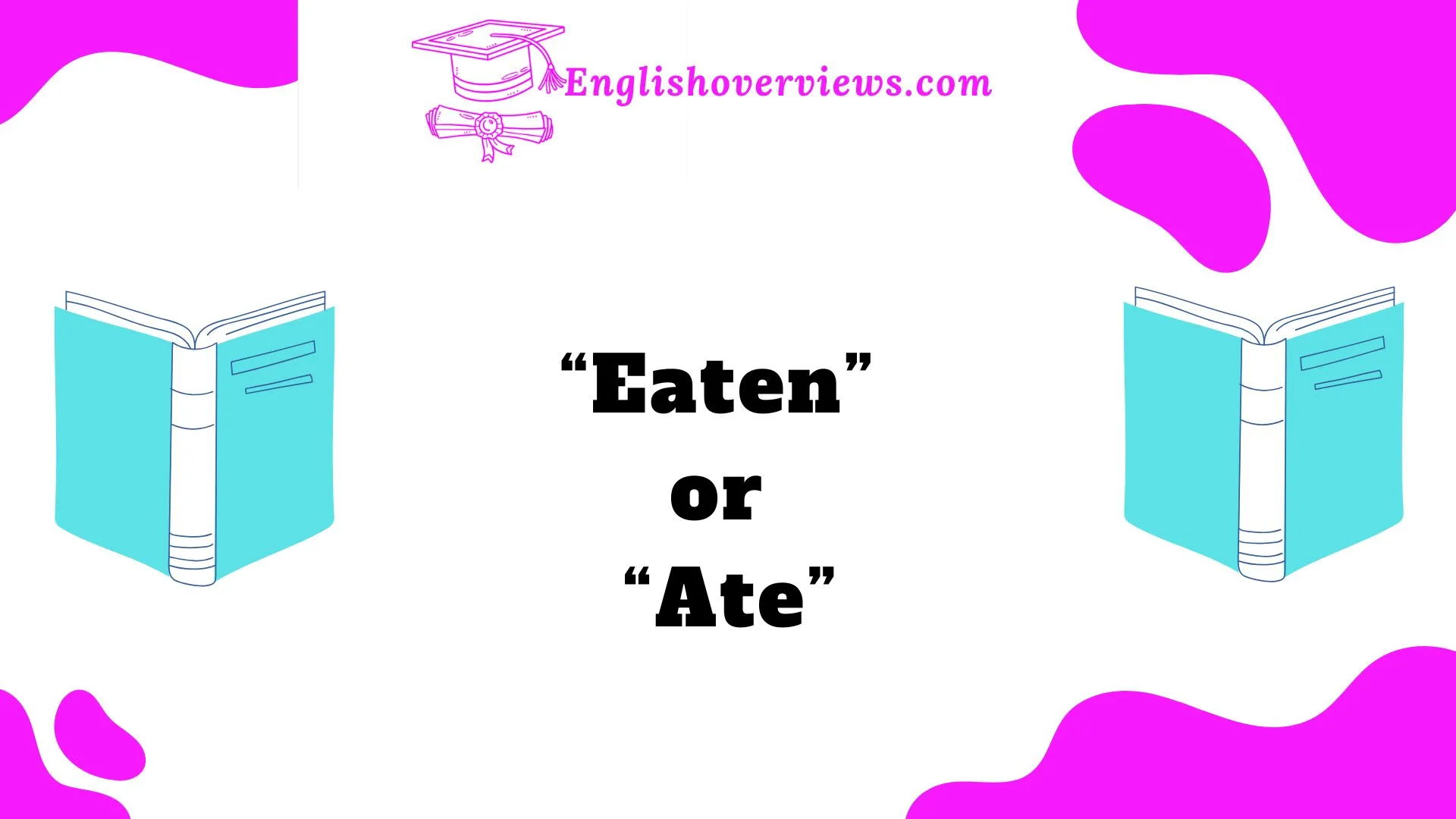Mastering English grammar can feel overwhelming, especially when two similar words seem interchangeable. For many learners and even native speakers, understanding when to use “eaten” or “ate” can be confusing.
These two words come from the verb “to eat,” but they serve very different purposes in sentences. Using them correctly isn’t just about grammar it’s about making your communication clear and professional.
In this guide, we’ll dive deep into the proper usage of “eaten” and “ate,” explore their role in tenses, and highlight common mistakes with real-world examples.
Whether you’re writing an email, an essay, or speaking casually, by the end of this post, you’ll know exactly which word to use and when.
Grasping the Core Difference Between “Eaten” and “Ate”
Understanding the distinction between “eaten” and “ate” begins with grasping the basics of verb forms.
Key Differences
| Verb Form | Function | Example |
| Base Form | The root form of the verb. | “I want to eat.” |
| Past Tense | Used to describe completed actions in the past. | “I ate lunch.” |
| Past Participle | Typically used in perfect tenses or passive constructions, often with auxiliary verbs. | “I have eaten breakfast.” |
“Ate” is the simple past tense of the verb. It stands alone to describe an action that happened at a specific time in the past.- Example: “I ate pizza last night.”
- “Eaten” is the past participle of the verb. It must be paired with an auxiliary verb (e.g., have, had, will have) to form perfect tenses or used in passive voice.
- Example: “I have eaten sushi before.”
Exploring the Role of “Eaten” in Perfect Tenses
Perfect tenses allow us to express actions in relation to other timeframes. Here’s how “eaten” fits into these structures:
Present Perfect Tense
- Formula: Subject + have/has + eaten
- Purpose: Describes actions completed at an unspecified time in the past or continuing into the present.
- Example:
- Correct: “I have eaten breakfast today.”
- Incorrect: “I have ate breakfast today.”
Real-World Application:
Imagine you’re hosting a business lunch, and someone asks, “Have you eaten?” The correct usage of “eaten” highlights the completion of the action, not just when it occurred.
Past Perfect Tense
- Formula: Subject + had + eaten
- Purpose: Highlights an action completed before another past action.
- Example:
- Correct: “She had eaten before the meeting started.”
- Incorrect: “She had ate before the meeting started.”
Case Study:
Think of a detective solving a mystery. “The suspect had eaten dinner before the crime took place.” This construction ensures clarity in the timeline.
Future Perfect Tense
- Formula: Subject + will have + eaten
- Purpose: Describes actions that will be completed before a specific future moment.
- Example:
- Correct: “By 8 PM, we will have eaten dinner.”
- Incorrect: “By 8 PM, we will have ate dinner.”
Scenario:
You’re planning an event and reassuring your guests. Saying, “We will have eaten by the time the show begins,” lets them know the schedule is under control.
Identifying “Ate” as the Simple Past Tense
“Ate” is straightforward but commonly misused. It’s the simple past tense and doesn’t require any auxiliary verbs.
Usage
- Formula: Subject + ate
- Purpose: Actions that happened once at a specific time in the past.
- Example:
- “I ate a sandwich at noon.”
- “We ate tacos after the game.”
Tips to Remember:
- Avoid adding auxiliary verbs with “ate.”
- Incorrect: “I have ate.”
- Correct: “I have eaten.”
Fun Fact:
Did you know “ate” was derived from the Old English word ætan, which meant “to eat”? Its simplicity is why it’s often favored in casual speech.
Common Pitfalls and Misuses of “Eaten” and “Ate”
Even fluent English speakers slip up when using these terms. Here’s how to avoid common errors:
1. Misusing “Ate” with Auxiliary Verbs
- Mistake: “I have ate too much cake.”
- Why it’s wrong: “Have” requires the past participle, not the past tense.
- Correct: “I have eaten too much cake.”
2. Forgetting the Role of “Eaten” in Passive Constructions
- Passive voice often relies on “eaten.”
- Correct: “The pizza was eaten by the kids.”
- Incorrect: “The pizza was ate by the kids.”
Tip: If you’re using “was” or “have,” pair it with “eaten” for proper grammar.
Real-Life Scenarios to Differentiate “Eaten” and “Ate”
Let’s compare casual conversations and professional writing to show the impact of proper usage:
Example 1 (Conversation):
- Friend: “Have you eaten?”
- You: “Yes, I ate already.”
Example 2 (Writing):
- Incorrect: “The team have ate breakfast.”
- Correct: “The team have eaten breakfast.”
Why It Matters: Correct verb use avoids misunderstandings and enhances clarity.
How to Enhance Your Writing with Accurate Verb Usage
Want to elevate your writing? Follow these tips:
- Practice with Examples:
- Write sentences for each tense using “eaten” and “ate.”
- Use Grammar Tools: Grammarly or ProWritingAid can catch errors.
- Ask Yourself: Does the sentence involve an auxiliary verb? If yes, use “eaten.”
FAQ Section
Q: What is the difference between “eaten” and “ate”?
A: “Eaten” is the past participle used with auxiliary verbs, while “ate” is the simple past tense used alone.
Q: Can I say, “I have ate dinner”?
A: No, the correct phrase is “I have eaten dinner.”
Q: Why is “eaten” used in passive voice?
A: “Eaten” functions with auxiliary verbs like “was” or “have” in passive constructions.
Q: Is it okay to use “ate” in formal writing?
A: Yes, as long as it’s used correctly as the simple past tense.
Q: How can I practice using “eaten” and “ate”?
A: Write sentences, use grammar exercises, and pay attention to examples in books or conversations.

English Overviews is a resourceful website dedicated to providing valuable content related to grammar and vocabulary. Muhammad Haroon has made notable contributions, sharing insights on various subjects, including WordPress themes and plugins. The primary goal of the site is to help users improve their English language skills effectively.











